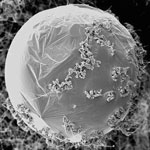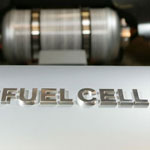Showing Spotlights 193 - 200 of 203 in category All (newest first):
 Nanotechnology applications could provide decisive technological breakthroughs in the energy sector and have a considerable impact on creating the sustainable energy supply that is required to make the transition from fossil fuels. Possibilities range from gradual short- and medium-term improvements for a more efficient use of conventional and renewable energy sources all the way to completely new long-term approaches for energy recovery and utilization. With enough political will - and funding - nanotechnology could make essential contributions to sustainable energy supply and global climate protection policies. The technological foundation is there, all it takes is political leadership to create the right research and investment conditions to make it happen.
Nanotechnology applications could provide decisive technological breakthroughs in the energy sector and have a considerable impact on creating the sustainable energy supply that is required to make the transition from fossil fuels. Possibilities range from gradual short- and medium-term improvements for a more efficient use of conventional and renewable energy sources all the way to completely new long-term approaches for energy recovery and utilization. With enough political will - and funding - nanotechnology could make essential contributions to sustainable energy supply and global climate protection policies. The technological foundation is there, all it takes is political leadership to create the right research and investment conditions to make it happen.
Sep 25th, 2008
 Storing the fuel that is needed to run a hydrogen car in a compact and affordable way is still a major challenge. You would need about 5 kg of hydrogen to have the same average driving range as today's cars. Since hydrogen's density is only 1/10th of a gram per liter at room temperature, that means you somehow need to pack 50,000 liters of hydrogen into your tank. There are three ways of doing this: as a high-pressure compressed gas; a cryogenic liquid; or as a solid. Rather than using hundreds of atmospheres to compress hydrogen into a tank, or cooling it down to minus 252 C to liquefy it, hydrogen storage in solid form offers the safest alternative for transportation and storage of hydrogen. Research in this area has led to metal hydrides, chemical hydrides, and physisorption-based storage, where hydrogen is adsorbed onto the interior surfaces of a porous material. The stored hydrogen can then be released by heat, electricity, or chemical reaction. Many metals are capable of absorbing hydrogen as well. The storage of gas in solids is not only an intriguing alternative for hydrogen storage but other types of gases, such as carbon dioxide and other environmentally important gases as well. Gas storage in solids is quickly becoming an important technology, with applications ranging from energy and the environment to biology and medicine. A new review article describes the types of material that make good porous gas storage materials, why different porous solids are good for the storage of different gases, and what criteria need to be met to make a useable gas storage material.
Storing the fuel that is needed to run a hydrogen car in a compact and affordable way is still a major challenge. You would need about 5 kg of hydrogen to have the same average driving range as today's cars. Since hydrogen's density is only 1/10th of a gram per liter at room temperature, that means you somehow need to pack 50,000 liters of hydrogen into your tank. There are three ways of doing this: as a high-pressure compressed gas; a cryogenic liquid; or as a solid. Rather than using hundreds of atmospheres to compress hydrogen into a tank, or cooling it down to minus 252 C to liquefy it, hydrogen storage in solid form offers the safest alternative for transportation and storage of hydrogen. Research in this area has led to metal hydrides, chemical hydrides, and physisorption-based storage, where hydrogen is adsorbed onto the interior surfaces of a porous material. The stored hydrogen can then be released by heat, electricity, or chemical reaction. Many metals are capable of absorbing hydrogen as well. The storage of gas in solids is not only an intriguing alternative for hydrogen storage but other types of gases, such as carbon dioxide and other environmentally important gases as well. Gas storage in solids is quickly becoming an important technology, with applications ranging from energy and the environment to biology and medicine. A new review article describes the types of material that make good porous gas storage materials, why different porous solids are good for the storage of different gases, and what criteria need to be met to make a useable gas storage material.
Jun 18th, 2008
 Fuel cells have gained a lot of attention because they provide a potential solution to our addiction to fossil fuels. Energy production from oil, coal and gas is an extremely polluting, not to mention wasteful, process that consists of heat extraction from fuel by burning it, conversion of that heat to mechanical energy, and transformation of that mechanical energy into electrical energy. In contrast, fuel cells are electrochemical devices that convert a fuel's chemical energy directly to electrical energy with high efficiency and without combustion (although fuel cells operate similar to batteries, an important difference is that batteries store energy, while fuel cells can produce electricity continuously as long as fuel and air are supplied). Modern fuel cells have the potential to revolutionize transportation. One of the leading fuel cell technologies developed in particular for transportation applications is the proton exchange membrane fuel cell, also known as polymer electrolyte membrane fuel cells - both resulting in the same acronym PEMFC
Fuel cells have gained a lot of attention because they provide a potential solution to our addiction to fossil fuels. Energy production from oil, coal and gas is an extremely polluting, not to mention wasteful, process that consists of heat extraction from fuel by burning it, conversion of that heat to mechanical energy, and transformation of that mechanical energy into electrical energy. In contrast, fuel cells are electrochemical devices that convert a fuel's chemical energy directly to electrical energy with high efficiency and without combustion (although fuel cells operate similar to batteries, an important difference is that batteries store energy, while fuel cells can produce electricity continuously as long as fuel and air are supplied). Modern fuel cells have the potential to revolutionize transportation. One of the leading fuel cell technologies developed in particular for transportation applications is the proton exchange membrane fuel cell, also known as polymer electrolyte membrane fuel cells - both resulting in the same acronym PEMFC
May 13th, 2008
 It wasn't market forces that landed a man on the moon; and It wasn't market forces that led France to build a nuclear energy infrastructure that now enables it to generate some 75% of its entire energy needs from nuclear power (just an example of what energy policy can do; let's not get into a discussion here of nuclear energy, though). But somehow, the leading political and industrial forces in the United States - together with China the largest emitter of greenhouse gases on the planet - think that a task so fundamental and massive as fighting global warming and environmental pollution should mostly be left 'to the market'. Unfortunately, it's just a matter of economic reality that 'the market' will not invest in new energy technologies on a large scale until existing ways of producing energy become more expensive than producing alternative energies - which at the moment they aren't. As is the case with almost all emerging technologies, government initially lends a helping hand before the technology becomes a viable commercial proposition and the market takes over (remember how the Internet got created?). In the case of future clean energy technologies, it appears that this 'helping hand' needs to be massive and swift. It's not so much that clean/green tech wouldn't develop over time on its own. But it's against the backdrop of accelerating global warming that it becomes a top priority that requires massive public resources.
It wasn't market forces that landed a man on the moon; and It wasn't market forces that led France to build a nuclear energy infrastructure that now enables it to generate some 75% of its entire energy needs from nuclear power (just an example of what energy policy can do; let's not get into a discussion here of nuclear energy, though). But somehow, the leading political and industrial forces in the United States - together with China the largest emitter of greenhouse gases on the planet - think that a task so fundamental and massive as fighting global warming and environmental pollution should mostly be left 'to the market'. Unfortunately, it's just a matter of economic reality that 'the market' will not invest in new energy technologies on a large scale until existing ways of producing energy become more expensive than producing alternative energies - which at the moment they aren't. As is the case with almost all emerging technologies, government initially lends a helping hand before the technology becomes a viable commercial proposition and the market takes over (remember how the Internet got created?). In the case of future clean energy technologies, it appears that this 'helping hand' needs to be massive and swift. It's not so much that clean/green tech wouldn't develop over time on its own. But it's against the backdrop of accelerating global warming that it becomes a top priority that requires massive public resources.
Apr 30th, 2008
 The race is on to develop the next generation of nanotechnology-enabled electrochemical energy storage devices, also knows as batteries. Lithium of course has long been recognized as an ideal material for energy storage due to its light weight and high electrochemical energy potential, as witnessed by the ubiquitous use of Li-ion batteries. There still seems to be considerable potential to further improve the performance characteristics of these Li-ion batteries. There have been many design approaches to creating lithium ion batteries but they usually share common features: The positive electrode is typically a lithium metal oxide, with various metals used such as cobalt, nickel, and manganese. The negative electrode is typically a carbon compound or natural or synthetic graphite. Researchers in Germany have now demonstrated a simple route for transforming cheap commercial carbon nanotubes into highly efficient carbon for electrochemical energy storage applications. When tested as electrode materials for lithium batteries, this composite material exhibits excellent performance over long test cycles.
The race is on to develop the next generation of nanotechnology-enabled electrochemical energy storage devices, also knows as batteries. Lithium of course has long been recognized as an ideal material for energy storage due to its light weight and high electrochemical energy potential, as witnessed by the ubiquitous use of Li-ion batteries. There still seems to be considerable potential to further improve the performance characteristics of these Li-ion batteries. There have been many design approaches to creating lithium ion batteries but they usually share common features: The positive electrode is typically a lithium metal oxide, with various metals used such as cobalt, nickel, and manganese. The negative electrode is typically a carbon compound or natural or synthetic graphite. Researchers in Germany have now demonstrated a simple route for transforming cheap commercial carbon nanotubes into highly efficient carbon for electrochemical energy storage applications. When tested as electrode materials for lithium batteries, this composite material exhibits excellent performance over long test cycles.
Apr 29th, 2008
 Two of the major challenges of our modern, mobile society are the shrinking of available fossil energy resources on one hand and climate change associated with global warming on the other. Continuing population growth multiplied by the increase in consumption and living standards, especially in developing countries, will require more and more oil, coal and natural gas to 'power' humanity. Notwithstanding efforts like the Kyoto Protocol - which wasn't signed by the two major CO2 polluters China and the U.S. - an ever increasing rate of fossil fuel usage means that the increasing emission of CO2 is likely to cause an acceleration of the climate change that is in progress already. Transportation, in particular passenger cars, is one of the areas where new technology could lead to environmental beneficial change. Never mind that GM is still selling 15-20,000 Hummers a year, or that Tata is planning to sell millions of its new Nano car. One of the much touted technological solutions is to substitute fossil hydrocarbon based energy with the energy from carbon-free sources like the sun, nuclear energy, or the hot interior of the Earth and use hydrogen as an energy carrier. Hydrogen can be produced from water using energy from carbon-free sources and can serve as fuel in fuel cells to generate electricity, either stationary or on board of vehicles. Considerable research efforts are going into the evaluation of various nanostructures, such as carbon nanotubes, to find the most suitable hydrogen storage materials.
Two of the major challenges of our modern, mobile society are the shrinking of available fossil energy resources on one hand and climate change associated with global warming on the other. Continuing population growth multiplied by the increase in consumption and living standards, especially in developing countries, will require more and more oil, coal and natural gas to 'power' humanity. Notwithstanding efforts like the Kyoto Protocol - which wasn't signed by the two major CO2 polluters China and the U.S. - an ever increasing rate of fossil fuel usage means that the increasing emission of CO2 is likely to cause an acceleration of the climate change that is in progress already. Transportation, in particular passenger cars, is one of the areas where new technology could lead to environmental beneficial change. Never mind that GM is still selling 15-20,000 Hummers a year, or that Tata is planning to sell millions of its new Nano car. One of the much touted technological solutions is to substitute fossil hydrocarbon based energy with the energy from carbon-free sources like the sun, nuclear energy, or the hot interior of the Earth and use hydrogen as an energy carrier. Hydrogen can be produced from water using energy from carbon-free sources and can serve as fuel in fuel cells to generate electricity, either stationary or on board of vehicles. Considerable research efforts are going into the evaluation of various nanostructures, such as carbon nanotubes, to find the most suitable hydrogen storage materials.
Jan 21st, 2008
 The problem with most current hydrogen sensor designs is that they are built on rigid substrates, which cannot be bent, and therefore, their applications might be limited due to the mechanical rigidity. In addition, they use expensive, pure palladium. A new type of sensors is bendy and use single-walled carbon nanotubes to improve efficiency and reduce cost. In the example of the space shuttle, laminating a dense array of flexible sensors on the whole surface of a pipe can detect any leakage of hydrogen prior to diffusion and alert control units to remedy the malfunction.
The problem with most current hydrogen sensor designs is that they are built on rigid substrates, which cannot be bent, and therefore, their applications might be limited due to the mechanical rigidity. In addition, they use expensive, pure palladium. A new type of sensors is bendy and use single-walled carbon nanotubes to improve efficiency and reduce cost. In the example of the space shuttle, laminating a dense array of flexible sensors on the whole surface of a pipe can detect any leakage of hydrogen prior to diffusion and alert control units to remedy the malfunction.
Oct 11th, 2007
 Back in January, when the U.S. president announced his hydrogen fuel initiative and proposed to spend a total of $1.7 billion over the next five years to develop hydrogen-powered fuel cells, hydrogen infrastructure and advanced automotive technologies, he said that it will be practical and cost-effective for large numbers of Americans to choose to use clean, hydrogen fuel cell vehicles by 2020. According to the U.S. Department of Energy's (DOE) Hydrogen Program, the government's goal is to achieve "technology readiness" by around 2015 in order to allow industry to make decisions on commercialization by then. That's only eight years to go. Given where the technology is today, this goal seems very ambitious, to say the least. Nanotechnology could help speed up the journey to the hydrogen society, but it will take some sensational breakthroughs on the way. The three key areas for the vehicles (we will not touch on the infrastructure issues here) are clean - the emphasis is on clean - hydrogen production, hydrogen storage, and the fuel cell itself. We'll take a look at how nanotechnology will play a role in these areas.
Back in January, when the U.S. president announced his hydrogen fuel initiative and proposed to spend a total of $1.7 billion over the next five years to develop hydrogen-powered fuel cells, hydrogen infrastructure and advanced automotive technologies, he said that it will be practical and cost-effective for large numbers of Americans to choose to use clean, hydrogen fuel cell vehicles by 2020. According to the U.S. Department of Energy's (DOE) Hydrogen Program, the government's goal is to achieve "technology readiness" by around 2015 in order to allow industry to make decisions on commercialization by then. That's only eight years to go. Given where the technology is today, this goal seems very ambitious, to say the least. Nanotechnology could help speed up the journey to the hydrogen society, but it will take some sensational breakthroughs on the way. The three key areas for the vehicles (we will not touch on the infrastructure issues here) are clean - the emphasis is on clean - hydrogen production, hydrogen storage, and the fuel cell itself. We'll take a look at how nanotechnology will play a role in these areas.
Jul 19th, 2007
 Nanotechnology applications could provide decisive technological breakthroughs in the energy sector and have a considerable impact on creating the sustainable energy supply that is required to make the transition from fossil fuels. Possibilities range from gradual short- and medium-term improvements for a more efficient use of conventional and renewable energy sources all the way to completely new long-term approaches for energy recovery and utilization. With enough political will - and funding - nanotechnology could make essential contributions to sustainable energy supply and global climate protection policies. The technological foundation is there, all it takes is political leadership to create the right research and investment conditions to make it happen.
Nanotechnology applications could provide decisive technological breakthroughs in the energy sector and have a considerable impact on creating the sustainable energy supply that is required to make the transition from fossil fuels. Possibilities range from gradual short- and medium-term improvements for a more efficient use of conventional and renewable energy sources all the way to completely new long-term approaches for energy recovery and utilization. With enough political will - and funding - nanotechnology could make essential contributions to sustainable energy supply and global climate protection policies. The technological foundation is there, all it takes is political leadership to create the right research and investment conditions to make it happen.
 Subscribe to our Nanotechnology Spotlight feed
Subscribe to our Nanotechnology Spotlight feed




